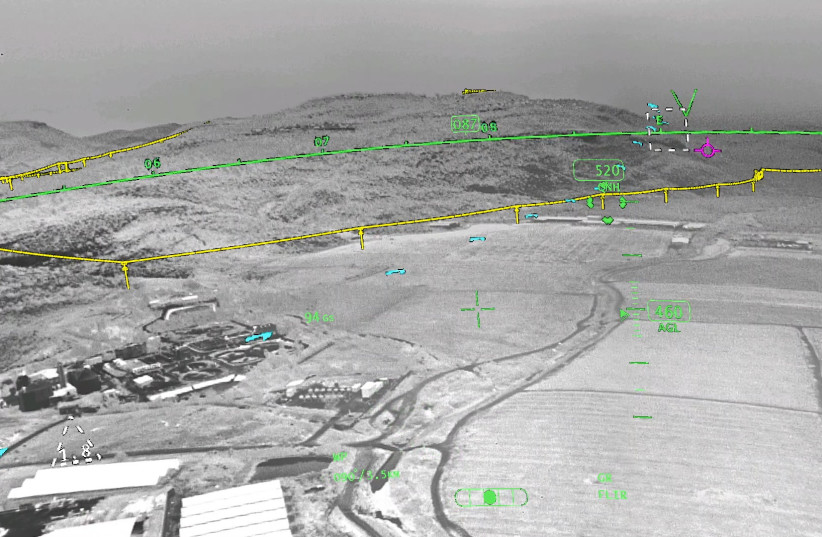While hi-tech fighter pilots might be splashed across theaters this summer with Top Gun: Maverick taking to the skies, helicopter pilots will now have a helmet more advanced than F-35 pilots, using Elbit’s X-Sight augmented-reality helmet-mounted display system.
Already viewed by potential clients around the world, the helmet was developed to be used in the Future Vertical Lift program as well as the Israeli Air Force’s new helicopter array.
With advanced avionics that provide pilots with more information than any other helmet, the X-Sight brings new capabilities to pilots so that they can “own the weather,” said Aviel Yahav, head of business development and marketing at Elbit Systems.
“This is a system made for pilots by pilots."
Aviel Yahav, head of business development and marketing at Elbit Systems
“This is a system made for pilots by pilots,” he said, before The Jerusalem Post viewed the system during a test flight from one of Elbit’s factories in northern Israel.
The new suite integrates a sophisticated sensor array, Artificial Intelligence-powered mission computer and an Augmented Reality (AR) Helmet-Mounted Display (HMD) system. It allows the helicopter pilot to see through the body of the aircraft.
Yahav explained that as mission complexity in a multi-aircraft area expands, so does the need for threat avoidance, and pilots require advanced avionics to receive more real-time information.
AI-powered helmet
Elbit’s new technological suite for X-Sight includes the AI-powered mission computer for real-time data fusion and machine learning of obstacles and threats, and for running operational applications. It also includes an integrated array of sensor systems combining the innovative Xplore radar together with the operational BrightNite multi-spectral payload that includes day camera and Infra-Red cameras for thermal vision.
The X-Sight system provides the pilots with a real-time, clear, colored wide field of view at all times and in all weather conditions. It allows the helicopter pilots to see a terrain grid with data points overlaid on real-world images with a dual-eye 61x30 degree view, and a visor-projected display that is in full color and high resolution.
Pilots are able to switch between various operational applications, either from day flight to flight during heavy fog or snow, analysis regarding a landing pad, obstacle mapping, and more.
The system that already incorporates a night-vision feature that pilots can switch on or off also has natural depth perception and hybrid optical inertial tracker and low latency. The LLTV camera has a seamless in-flight sensor, and allows for transition-target allocation as well as moving target indication to warn pilots of possible incoming threats.
X-Sight has a range of 2000m. with a wide field of view of 100x50, and incorporates Elbit’s innovative XPlore Radar, which is a compact, sophisticated airborne radar that can be installed on any aircraft. It allows pilots to fly in degraded weather conditions, including brownouts, as if they were flying during the day in clear weather.
“This technology that we developed is bringing the fifth-generation capability from the F-35 to the helicopter fleet of combat helicopters and utility helicopters, allowing pilots to fly in any degraded visual environment and turning this degraded visual environment from a limitation to an operational benefit,” he said.
The AI-powered mission computer fuses all the sensors’ information together with pre-installed maps, flight and mission data, and presents the pilot on his/her visor with a real-time color picture that includes the AR overlay.

It also continuously tracks the landscape to warn pilots of potential obstacles such as power lines, antennas and other interferences, without prior mapping, enabling a low-altitude flight even in zero visibility, while also providing pilots of ground and midair collision avoidance. With layers of information gathered from satellites, pilots can fly in GPS-denied zones.
Installed on the helicopter’s nose, the integrated sensor array (BrightNite and the Xplore radar) stares at the flight path in a wide-angle.
“The new technology provides helicopter pilots with an F-35-grade HMD (Helmet Mounted Display) system, Elbit said, adding that the changes made to the helmet not only leverage the sensors installed on the platform, but also advanced AI and fusion capabilities to process and provide a unified image for pilots.
Helmet could be used by air forces around the world
Though Elbit would not comment on possible sales, the system was designed in an open architecture with full compliance with US military standards for both hardware and software, offering flexibility for users and partners.
It enables air forces from around the world to integrate sensors made by different companies, as well as to use varying configurations and develop and install additional applications on the mission computer.
“These capabilities address one of the toughest operational challenges of military helicopters: enabling low-altitude flights during degraded visibility conditions, significantly expanding the operational envelope of military helicopters, practically turning extreme weather and other degraded visibility conditions to operational advantage,” the statement added.
